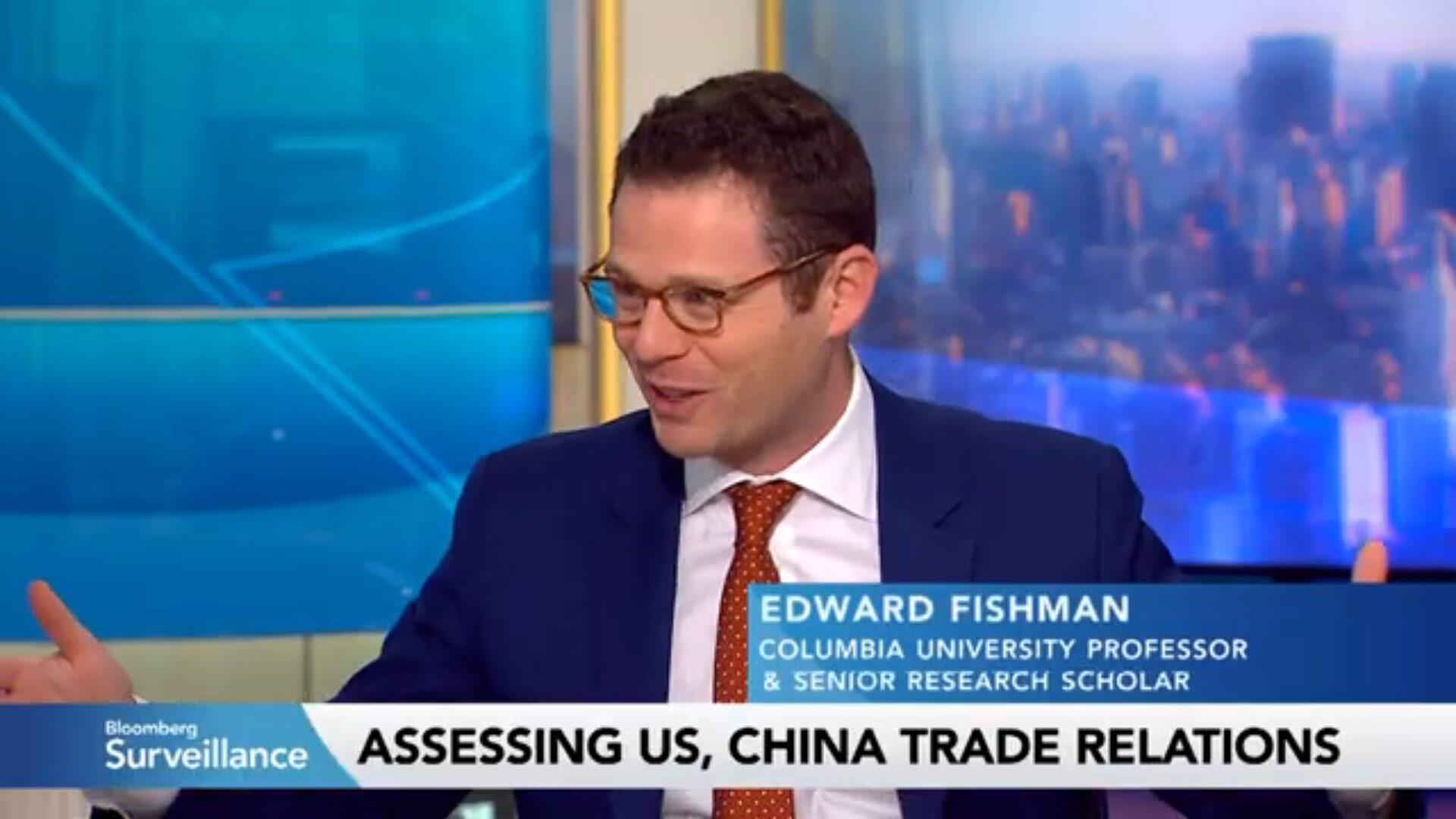
Edward Fishman on Bloomberg: Global Energy Policy
Edward Fishman joins Bloomberg on October 30, 2025. Edward Fishman is one of the world’s foremost experts on economic statecraft, with deep experience shaping U.S.…
Thought Leader: Edward Fishman
By EVAN A. FEIGENBAUM, BARBARA WEISEL
The inauguration of a new U.S. administration offers a quadrennial opportunity to reassess American strategic and economic priorities. And to their credit, President Joe Biden and his administration have already reaffirmed a commitment to a growing bipartisan emphasis on China as a strategic challenge to America’s national security and economic competitiveness.
For the last four years, but especially in the last two, former president Donald Trump and his administration settled on collaboration with Taiwan as a fulcrum of U.S.-China competition. The Trump administration broadened contact guidelines for U.S. officials to engage with Taipei and argued that a broadened partnership with Taiwan could be an additional element of American power and purpose in the Pacific.
But despite the inauguration of a new dialogue forum and some high-profile political gestures during Trump’s tenure, the economic component of the U.S.-Taiwan relationship ultimately failed to match its promise. One reason is that Taipei’s goals were mismatched with U.S. trade policy priorities. Bluntly put, Taipei’s principal economic objective and urgent priority in its relations with Washington has been to secure a bilateral trade agreement (BTA); yet that objective ran squarely into the Trump trade team’s frustration over long-standing market access barriers in Taiwan and reluctance to divert focus from higher priority negotiations with other major economies.
A new administration, therefore, offers an opportunity to reevaluate. But even with broad-based bipartisan political support for a BTA in Congress and the change in administration, BTA negotiations with Taiwan may not be in the offing anytime soon. After all, the Biden team will need many months to settle on its trade agenda, consider new Trade Promotion Authority (which will expire on July 1, 2021), decide whether and how to prioritize among prospective bilateral and plurilateral trade agreements, and then launch negotiations, if at all.
The danger is that advocates for a deepened U.S.-Taiwan economic partnership could find themselves at least twelve to eighteen months into the Biden administration before U.S. trade officials even begin weighing the prospect of an agreement. Focusing solely on a BTA and little else thereby risks crowding out other productive ideas, initiatives, and policy innovations.
That would be a tragedy for both sides. While a BTA with Taipei is certainly desirable, it is hardly the only way to enhance U.S.-Taiwan economic relations.
For its part, the United States benefits from robust economic ties with Taiwan—Asia’s seventh- largest economy, America’s tenth-largest trading partner in goods, and an important link in global high-technology supply chains because of its best-in-class semiconductor design and fabrication companies. Increased suspicion of Made in China advanced technology products has led some U.S. firms to view Taiwan as a secure and trusted partner. And the growing aversion in many economies, including but not limited to the United States, to China-origin artificial intelligence–enabled products and other software applications has made Taiwan a potentially attractive substitute for products designed or manufactured in mainland China.
Likewise, Taiwan benefits enormously from robust economic ties to the United States—one of its top five export markets and an essential technology partner. Taiwan, in effect, discovered Silicon Valley decades before the rest of the world did. Since the 1970s, the process of “brain circulation” of Taiwan-born, U.S.-educated and -trained engineers and entrepreneurs with close ties to, and ongoing relationships with, the valley and other U.S. innovation hubs has driven a wave of entrepreneurial growth in semiconductors, personal computers, and other hardware-related industries.
But Taipei also views closer economic ties with the United States as a strategic benefit in the face of pressure from Beijing. Taiwan wants a broader array of commercial ties and partnerships and has bet that, as the United States seeks to expand its economic partnership with Taiwan, other major economies could potentially follow.
With or without a BTA, then, a stronger trade, investment, and innovation relationship between the United States and Taiwan would help to lock in mutually beneficial gains. And because both Washington and Taipei are members of the Asia-Pacific Economic Cooperation (APEC) forum, a broader agenda in APEC would be one way to negotiate a formal system of shared standards, principles, and understandings. Another would be to broaden the scope and nature of their bilateral economic engagement.
The immediate priority for both Washington and Taipei should be an early harvest of quick wins. It will take time for the Biden administration to decide whether to launch a plurilateral sectoral trade initiative in which Taiwan might participate. So other complementary bilateral initiatives that could move more quickly should, at this point, be the immediate goal.
The two sides should begin by agreeing to pursue a series of initiatives, recognizing the possibility of rolling them into a plurilateral effort later on, if appropriate.
As a first step, and to demonstrate that deepened economic ties are a high priority, the United States and Taiwan should hold formal meetings as soon as possible to establish their intent to achieve concrete progress on key trade and investment issues of common concern.
From the authors’ prior experience in government, comprehensive dialogues that seek to cover all issues tend to become formalistic and scripted, and they have generally achieved little besides formulating a long laundry list of initiatives with limited value. The solution is to pursue separate, but parallel, dialogue tracks with well-coordinated outreach (including on public messaging) led by government agencies with the relevant authority. These parallel dialogues have proven to be nimbler and more capable of achieving faster and more meaningful progress on a range of priorities than comprehensive, one-size-fits-all forums have been.
Specifically, Presidents Biden and Tsai Ing-wen should task their teams with initiating three interrelated dialogues. The goal would be for Washington and Taipei to announce a limited set of initiatives that they intend to conclude on a short time frame at each forum.
First, the U.S. State Department, with the participation of other relevant agencies, should host a senior-level bilateral meeting (along the lines of the U.S.-Taiwan bilateral Economic Prosperity Partnership Dialogue) with an agenda focused on immediate deliverables, including:
Second, the Office of the U.S. Trade Representative, along with the Commerce Department and other relevant agencies, should host a Trade and Investment Framework Agreement (TIFA) meeting as soon as possible. This bilateral forum already exists and is ready-made to move quickly. But a formal TIFA meeting has not been held since 2016, when former president Barack Obama was still in office.
For Washington, holding a quick TIFA meeting with counterparts from Taipei would signal the United States’ commitment to reestablishing regular engagement with Taiwan to deepen trade relations. Doing so would also help erase lingering questions surrounding the United States’ unwillingness to hold a formal meeting over the past four years.
In addition to seeking to resolve ongoing trade irritants, the two sides should agree in this dialogue to pursue:
Washington and Taipei also should use the forum to coordinate positions on WTO reform and other items on the APEC agenda.
On a third track, the Commerce Department should host a meeting, in coordination with its Taiwan counterparts and leading business associations, to promote bilateral trade and investment opportunities and partnerships. Such a meeting could be held back-to-back and regularly with the TIFA or the State Department–led dialogue, so that all three dialogues become iterative tracks of a three-pronged approach. The U.S. side should include the range of export finance and trade promotion agencies. The two sides also could discuss infrastructure development in third countries to support Taiwan’s New Southbound Policy, which aims to broaden cooperation with eighteen countries in Southeast Asia, South Asia, and Oceania, as well as other regional initiatives.
For example, commercial energy partnerships between U.S. and Taiwan firms in Southeast Asia, where Taiwan firms already have deep connections, would reflect Taipei’s emphasis on that geographic region in its New Southbound initiative while also reflecting the U.S. emphasis on infrastructure and development opportunities in the Indo-Pacific.
The two sides could aim to leverage commercial partnerships, such as encouraging U.S. energy firms to make greater use of engineering, procurement, and construction (EPC) partners based in Taiwan. Many of these U.S. companies are already working with local EPCs on their projects in Taiwan. One prospective model, then, would be to leverage existing U.S.-Taiwan EPC partnerships so that Taiwan-based EPC firms could be bid partners on projects in Southeast Asia or elsewhere. Ultimately, deepening such partnerships would require measures by Taipei to bring down costs; Taiwan needs policies that incentivize competition among EPCs. But this topic, too, could be addressed within a U.S. Commerce Department–led dialogue track, showcasing the many ways Washington and Taipei are looking not just at a potential BTA but well beyond it to capture the full range of bilateral, regional, and global opportunities.
The United States and Taiwan have every reason to develop their economic partnership further. Making good on this potential, however, will require broadening their agenda; pursuing a multifaceted set of dialogues, agreements, projects, and other initiatives; and reflecting the interests of a wider array of public and especially private players.
Edward Fishman on Bloomberg: Global Energy Policy
Edward Fishman joins Bloomberg on October 30, 2025. Edward Fishman is one of the world’s foremost experts on economic statecraft, with deep experience shaping U.S.…
Thought Leader: Edward Fishman
4 Strategies Providers Are Using to Strengthen the Healthcare Workforce
During Reuters’ Total Health conference in Chicago, four healthcare leaders shared the strategies they believe will help fortify the workforce for the future. Healthcare’s workforce crisis continues…
Thought Leader: Dave Chokshi
Lisa Bodell: Smart Leaders Sabotage Their Own Strategies
Traditional strategic planning is often more of a ritual than a breakthrough moment. Teams gather, review last year’s metrics, and churn out a cookie-cutter annual…
Thought Leader: Lisa Bodell

